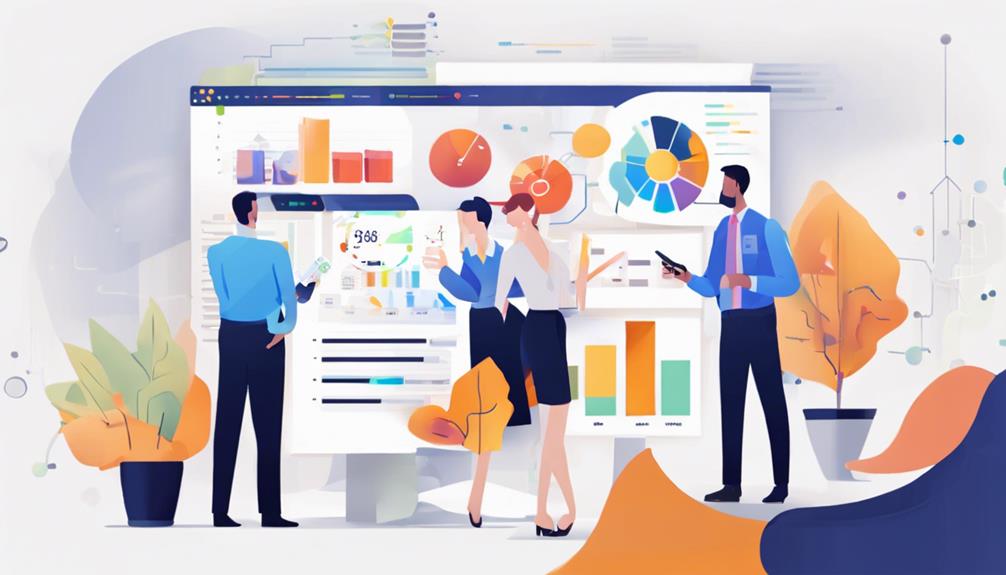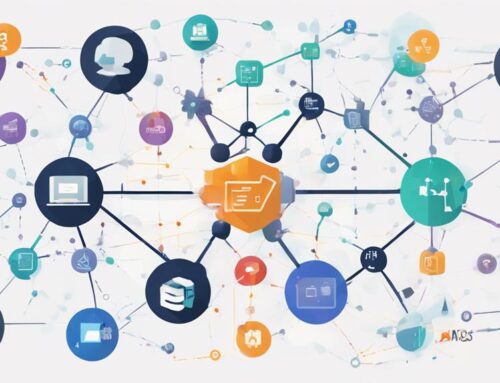To leverage data enrichment effectively in B2B sales, you must first understand the significance of harnessing enriched data for strategic decision-making. By incorporating targeted leads and personalized interactions into your sales approach, you can unlock new opportunities to drive revenue and enhance customer relationships. However, simply having access to enriched data is not enough. The key lies in how you interpret and apply this data to refine your sales tactics and stay ahead of the competition. Ready to discover the transformative impact of data enrichment in elevating your B2B sales game?
Define Sales Objectives
To effectively leverage data enrichment in B2B sales, the first crucial step is to define clear and measurable sales objectives. Goal setting is essential in guiding your team towards a common purpose and ensuring alignment with the overall business strategy. Begin by establishing specific, achievable objectives that are directly linked to your company’s growth targets. These goals should be measurable so that you can track progress and make data-driven decisions. Metrics tracking plays a pivotal role in evaluating the effectiveness of your sales strategies and identifying areas for improvement. By defining key performance indicators (KPIs) related to your sales objectives, you can monitor your team’s performance, assess the impact of data enrichment efforts, and adjust your approach accordingly. Regularly reviewing these metrics will enable you to stay on course, optimize your sales processes, and ultimately drive meaningful results in your B2B sales endeavors.
Identify Target Leads
Identifying target leads is a critical aspect of successful B2B sales strategies. To effectively identify target leads, it is essential to leverage data enrichment tools. Start by segmenting your audience based on criteria such as industry, company size, or past interactions. Utilize lead scoring to prioritize leads based on their likelihood to convert. Implementing lead scoring allows your sales team to focus their efforts on leads that are more likely to result in successful conversions.
Customized outreach is another key component in identifying target leads. Tailoring your messaging to address specific pain points or needs of the leads can significantly increase engagement and conversion rates. Utilize the enriched data to personalize your outreach and provide value to the leads at every touchpoint.
Enrich Sales Data
Enhancing your sales data plays a pivotal role in optimizing your B2B sales process. By enriching your sales data with additional information, such as firmographic details, contact information, and behavioral insights, you gain a deeper understanding of your leads and customers. This enriched data empowers your sales team to personalize interactions, tailor pitches, and anticipate customer needs more effectively.
Data visualization tools can help you make sense of this enriched data by presenting it in easy-to-understand visual formats. Visual representations like charts, graphs, and dashboards can reveal patterns, trends, and correlations that might otherwise go unnoticed. This visual insight enables your team to make data-driven decisions and prioritize high-potential leads.
Furthermore, leveraging predictive analytics on your enriched sales data can forecast future trends, identify potential opportunities, and even anticipate customer behavior. By harnessing the power of predictive analytics, you can proactively adjust your sales strategies and stay ahead of the competition.
Segment Enriched Data
Segmenting enriched data is a strategic approach that allows you to categorize leads and customers based on specific criteria or characteristics. By segmenting your enriched data effectively, you can tailor your marketing efforts and sales strategies to better suit the needs and preferences of different groups within your target audience. This personalized approach can significantly improve your conversion rates and overall sales performance.
To maximize the benefits of segmenting enriched data, consider the following:
- Lead segmentation: Divide your leads into categories based on factors such as industry, company size, or buying behavior. This enables you to create customized strategies for each group, increasing the relevance of your outreach efforts.
- Personalized outreach: Use the segmented data to personalize your outreach messages and communication with leads. Tailoring your approach to address specific pain points or interests can enhance engagement and drive better results.
- Targeted campaigns: Develop targeted marketing campaigns that speak directly to the needs of each segment. By delivering relevant content and offers, you can increase response rates and nurture leads more effectively.
Personalize Sales Pitch
To effectively personalize your sales pitch, you must craft tailored messaging strategies that resonate with your target audience. By utilizing customer insights gained through data enrichment, you can create impactful and relevant communication approaches. This targeted method ensures that your sales efforts are precise and compelling, leading to higher engagement and conversion rates.
Tailored Messaging Strategies
By tailoring your messaging strategies in B2B sales, you can significantly enhance your ability to connect with potential clients on a more personal level. Customized branding and tailored outreach are essential components to consider when crafting your messaging approach. Here’s how you can effectively implement tailored messaging strategies:
- Understand Your Audience: Conduct thorough research to grasp the specific needs, pain points, and preferences of your target clients. This information will enable you to tailor your messages to resonate with them on a deeper level.
- Segment Your Audience: Divide your target market into distinct segments based on demographics, behaviors, or preferences. Create tailored messages for each segment to ensure relevance and effectiveness.
- Personalize Communication: Use data enrichment tools to gather insights that allow you to personalize your communication. Address clients by name, reference previous interactions, and offer solutions that align with their unique requirements.
Customer Insights Utilization
To enhance your B2B sales strategy further, now let’s focus on leveraging customer insights for a personalized sales pitch approach. Personalization techniques play a crucial role in engaging potential clients effectively. By utilizing data analytics, you can gather valuable information about your customers, such as their preferences, pain points, and past interactions with your company. This data enables you to tailor your sales pitch to resonate with each individual prospect on a deeper level.
To implement personalization effectively, start by segmenting your target audience based on their characteristics and behaviors. This segmentation allows you to create customized messaging that speaks directly to the specific needs of each group. Additionally, leverage customer insights to anticipate objections or concerns that prospects may have, addressing them proactively in your sales pitch.
Data analytics tools can help you track customer behavior in real-time, allowing you to adapt your sales approach dynamically. By incorporating these insights into your sales strategy, you can increase engagement, build stronger relationships with clients, and ultimately drive more conversions.
Targeted Communication Approach
When crafting a personalized sales pitch for B2B interactions, honing in on a targeted communication approach is paramount. To effectively engage with potential clients, consider the following:
- Personalized Outreach: Tailoring your communication to address the specific needs and pain points of each prospect can significantly increase engagement and response rates. Utilize the insights gained from data enrichment to personalize your outreach and make a meaningful connection with your audience.
- Customized Messaging: Develop messaging that resonates with the unique challenges and goals of your prospect. By customizing your communication, you demonstrate an understanding of their business and position yourself as a valuable partner who can provide solutions tailored to their needs.
- Adaptability: Remain flexible in your approach and be prepared to adjust your messaging based on the feedback and interactions you receive. By adapting your communication to align with the evolving needs of your prospect, you can build stronger relationships and increase your chances of closing the deal.
Track Sales Performance
Enhancing your ability to track sales performance is crucial in optimizing your B2B sales strategy. By effectively monitoring progress and analyzing trends, you gain valuable insights into the effectiveness of your sales efforts. Tracking sales performance allows you to identify what is working well and what areas need improvement, enabling you to make informed decisions to drive growth.
Utilizing data enrichment tools can provide you with detailed metrics on various aspects of your sales performance, such as conversion rates, customer acquisition costs, and sales cycle length. By tracking these key indicators, you can pinpoint areas of strength and weakness within your sales process.
Analyzing trends in your sales data can help you identify patterns and correlations that can guide your future sales strategies. By tracking sales performance consistently, you can adapt your approach in real-time, ensuring that you stay agile and responsive to market changes.
Adjust Strategy Based on Data
Optimizing your B2B sales strategy requires a proactive approach to adjusting your tactics based on data insights. Embracing data-driven decision making can significantly enhance your sales efforts. Here’s how you can adjust your strategy based on data:
- Identify Trends: Analyze the data to uncover patterns in customer behavior, such as preferred communication channels or peak buying times. Use this information to tailor your approach accordingly.
- Segmentation: Utilize data to segment your target audience based on factors like industry, company size, or past purchase history. This enables you to create customized outreach strategies that resonate with each specific group.
- Feedback Loop: Continuously gather feedback from your sales team and customers. Incorporate this feedback into your data analysis to refine and optimize your strategies over time.
Frequently Asked Questions
How Can Data Enrichment Help in Improving Lead Quality?
To boost lead quality, data enrichment enhances lead scoring accuracy and enables tailored personalization tactics. By enriching data with relevant insights, you refine targeting, increase conversion rates, and provide more personalized customer experiences, ultimately driving sales growth.
What Are the Key Sources for Enriching Sales Data?
To ensure data accuracy and completeness, key sources for enriching sales data include CRM systems, marketing automation platforms, third-party data providers, and social media platforms. Utilize data validation and cleansing techniques to enhance data quality.
How to Effectively Segment Enriched Data for Targeting?
Crafting customer personas allows for precise targeting. Prioritize accounts based on enriched data to boost conversions. Tailor personalized strategies for each segment. By fine-tuning your approach, you maximize engagement and foster valuable relationships.
Can Data Enrichment Assist in Improving Customer Retention?
Data enrichment can greatly enhance customer retention by providing insights for personalized interactions. Understand customer satisfaction levels to tailor loyalty programs effectively. Utilize enriched data to identify trends, preferences, and behavior patterns crucial for fostering long-lasting relationships.
What Metrics Should Be Tracked to Measure Sales Performance Accurately?
To measure sales performance accurately, track conversion rates and pipeline velocity. Did you know that a 1% increase in conversion rates can lead to a 10% boost in revenue? These metrics provide insight into operational efficiency and revenue growth potential.




